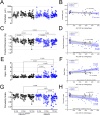Microglia remodeling in the visual thalamus of the DBA/2J mouse model of glaucoma
- PMID: 40373024
- PMCID: PMC12080812
- DOI: 10.1371/journal.pone.0323513
Microglia remodeling in the visual thalamus of the DBA/2J mouse model of glaucoma
Abstract
Microglia are the resident immune cells of the central nervous system and mediate a broad array of adaptations during disease, injury, and development. Typically, microglia morphology is understood to provide a window into their function and microglia have the capacity to adopt a broad spectrum of functional phenotypes characterized by numerous morphologies and gene expression profiles. Glaucoma, which leads to blindness from retinal ganglion cell (RGC) degeneration, is commonly associated with elevated intraocular pressure (IOP) and triggers microglia responses within the retinal layers, at the optic nerve head, and in retinal projection targets in the brain. The goal of this study was to determine the relationship of microglia morphology to intraocular pressure and the loss of RGC output synapses in the dorsolateral geniculate nucleus (dLGN), a RGC projection target in the thalamus that conveys information to the primary visual cortex. We accomplished this by analyzing microglia morphologies in dLGN sections from DBA/2J mice, which develop a form of inherited glaucoma, at 4, 9, and 12 months of age, representing distinct time points in disease progression. Microglia morphology was analyzed using skeletonized Iba1 fluorescence images and fractal analyses of individually reconstructed microglia cells. We found that microglia in older DBA/2J mice adopted simplified morphologies, characterized by fewer endpoints and less total process length per microglia cell. There was an age-dependent shift in microglia morphology in tissue from control mice (DBA/2JGpnmb+) that was accelerated in DBA/2J mice. Measurements of microglia morphology correlated with cumulative IOP, immunofluorescence labeling for complement component C1q, and vGluT2-labeled RGC axon terminal density. Additionally, fractal analysis revealed a clear distinction between control and glaucomatous dLGN, with microglia from ocular hypertensive DBA/2J dLGN tissue showing an elongated rod-like morphology. RNA-sequencing of dLGN showed an upregulation of immune system-related genes. These results suggest that microglia in the dLGN alter their physiology to respond to RGC degeneration in glaucoma, potentially contributing to CNS adaptations to neurodegenerative vision loss.
Copyright: © 2025 Thompson et al. This is an open access article distributed under the terms of the Creative Commons Attribution License, which permits unrestricted use, distribution, and reproduction in any medium, provided the original author and source are credited.
Conflict of interest statement
The authors have declared that no competing interests exist.
Figures








Similar articles
-
Nonuniform scaling of synaptic inhibition in the dorsolateral geniculate nucleus in a mouse model of glaucoma.bioRxiv [Preprint]. 2024 Mar 30:2024.03.27.587036. doi: 10.1101/2024.03.27.587036. bioRxiv. 2024. Update in: eNeuro. 2024 Jul 11;11(7):ENEURO.0263-24.2024. doi: 10.1523/ENEURO.0263-24.2024. PMID: 38586044 Free PMC article. Updated. Preprint.
-
Rho kinase inhibitor for primary open-angle glaucoma and ocular hypertension.Cochrane Database Syst Rev. 2022 Jun 10;6(6):CD013817. doi: 10.1002/14651858.CD013817.pub2. Cochrane Database Syst Rev. 2022. PMID: 35686679 Free PMC article.
-
Prescription of Controlled Substances: Benefits and Risks.2025 Jul 6. In: StatPearls [Internet]. Treasure Island (FL): StatPearls Publishing; 2025 Jan–. 2025 Jul 6. In: StatPearls [Internet]. Treasure Island (FL): StatPearls Publishing; 2025 Jan–. PMID: 30726003 Free Books & Documents.
-
Retinal ganglion cell apoptosis in glaucoma is related to intraocular pressure and IOP-induced effects on extracellular matrix.Invest Ophthalmol Vis Sci. 2005 Jan;46(1):175-82. doi: 10.1167/iovs.04-0832. Invest Ophthalmol Vis Sci. 2005. PMID: 15623771 Free PMC article.
-
Perioperative medications for preventing temporarily increased intraocular pressure after laser trabeculoplasty.Cochrane Database Syst Rev. 2017 Feb 23;2(2):CD010746. doi: 10.1002/14651858.CD010746.pub2. Cochrane Database Syst Rev. 2017. PMID: 28231380 Free PMC article.
References
MeSH terms
Grants and funding
LinkOut - more resources
Full Text Sources
Medical
Molecular Biology Databases

